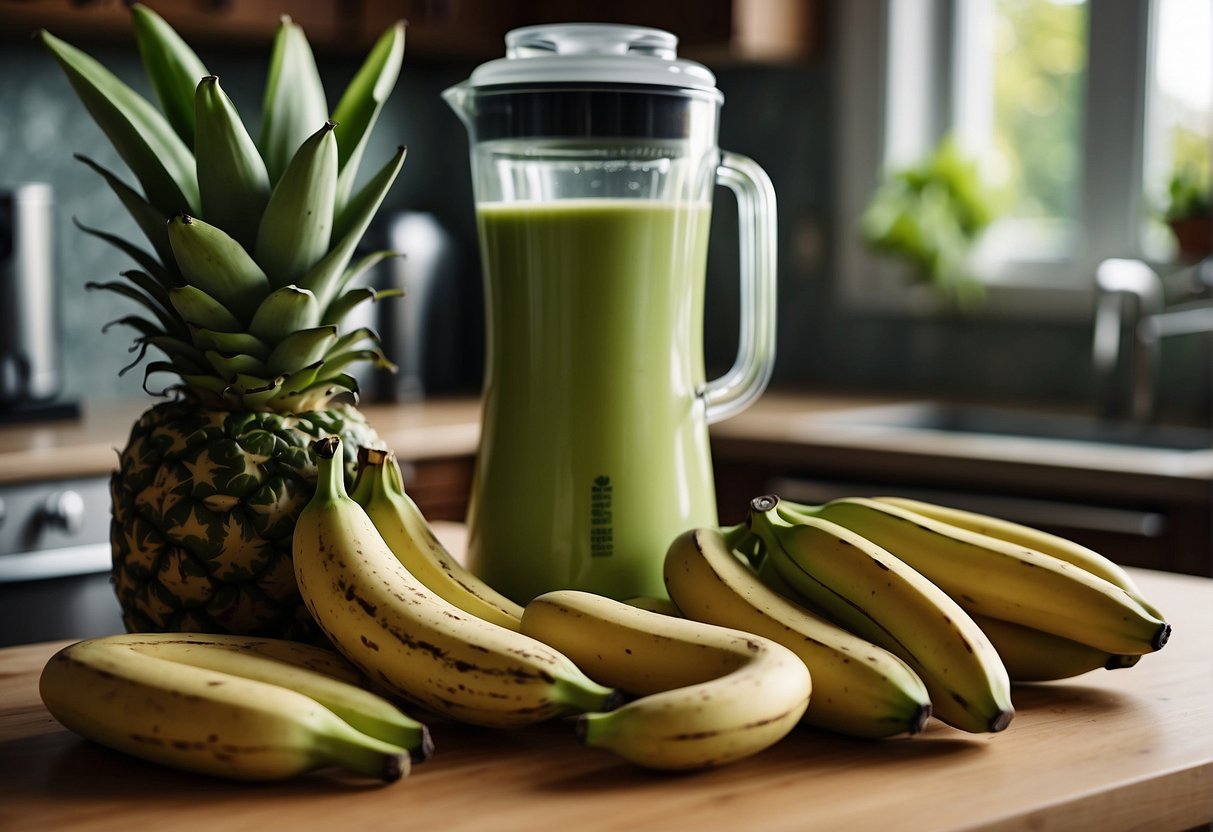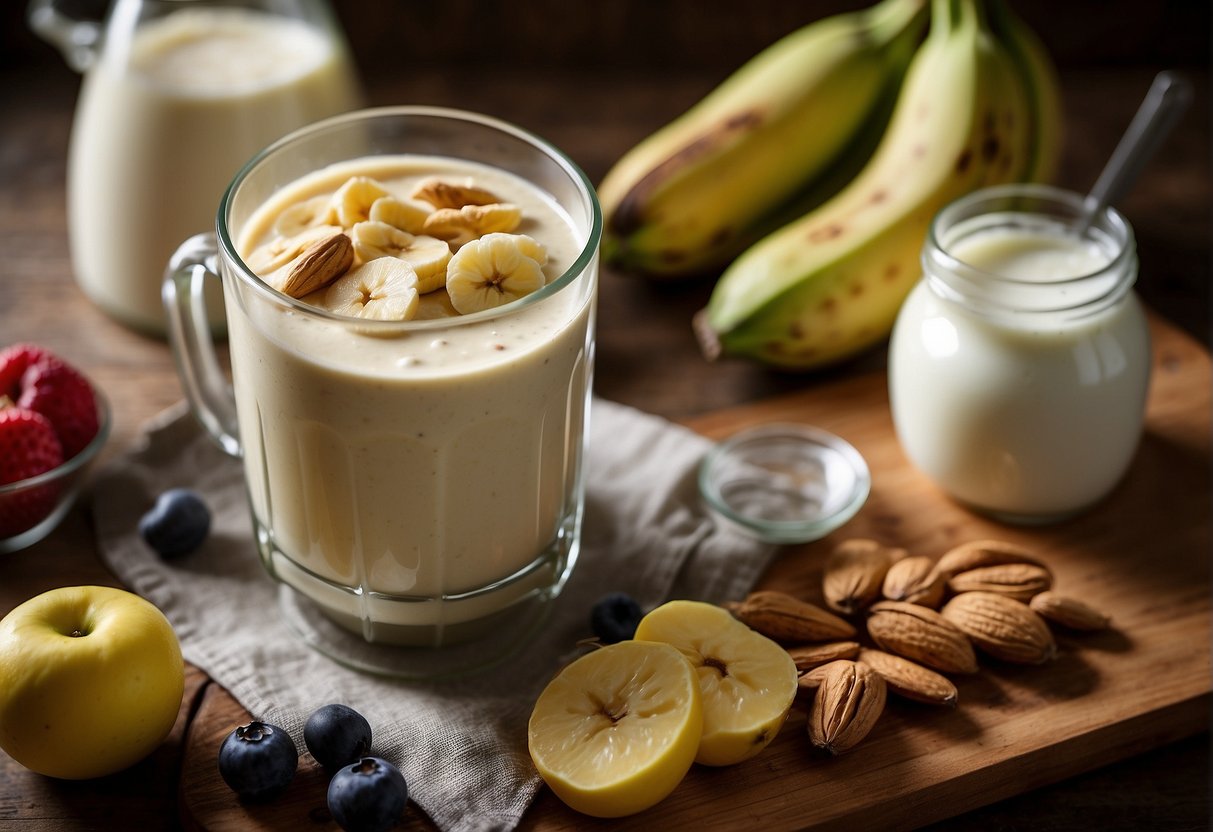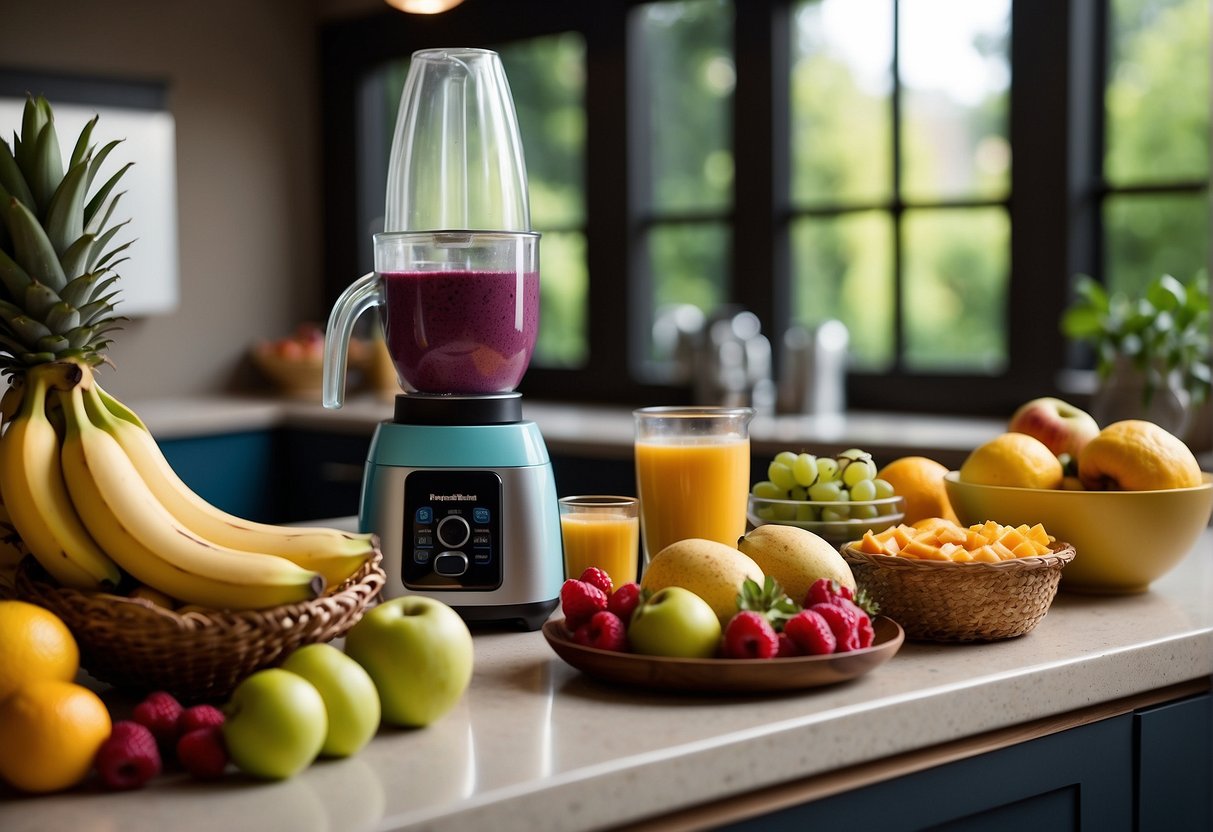Understanding Banana Ripeness and Smoothie Taste
In my quest to craft the perfect smoothie, I’ve found that the ripeness of a banana can significantly influence the sweetness and overall flavor profile. Let’s dive into the science behind it and what you can expect when choosing between unripe and ripe bananas.
The Role of Starch and Sugar in Bananas
Bananas are fascinating fruits, especially when you look at their carbohydrate content. An unripe banana is packed with starch, which gives it a firmer texture and less sweetness. As bananas ripen, enzymes break down this starch into sugar, increasing the fruit’s sweetness. This transformation is key in dictating the taste of your smoothie. While ripe bananas can offer a natural dose of sweetness, unripe ones will not contribute much sugar, resulting in a less sweet smoothie.
Flavor Profile of Unripe vs. Ripe Bananas
When it comes to smoothie making, the flavor profile is critical. Unripe bananas have a more subtle sweetness blended with a hint of tartness, whereas ripe bananas are outright sweet. If I were to describe the taste, I’d say unripe bananas can often impart a slightly grassy or earthy flavor to your blend, while ripe bananas bring in a full-bodied, almost candy-like sweetness that most folks associate with banana-flavored treats. This contrast in taste isn’t just about preference; it’s about how the sugars develop and influence the overall flavor of your smoothie.
Choosing Bananas for Smoothies
When I’m aiming to whip up a smoothie, the bananas I select can make a big difference in taste and consistency. Let’s look at how going green or waiting for that yellow hue can impact my blend.
Pros and Cons of Using Unripe Bananas
Pros:
- Texture: Unripe, green bananas add a thicker, creamier texture to smoothies because they contain more starch.
- Health: They’re lower in sugar than ripe bananas, making them a healthier choice for those monitoring their sugar intake.
Cons:
- Taste: Green bananas are less sweet and can impart a slightly bitter taste.
- Digestibility: Since they’re high in resistant starch, they may be harder to digest for some people.
Ripening Process and Its Impact on Smoothies
Ripening: As bananas ripen, the starch converts to sugar, enhancing natural sweetness.
Smoothie Quality: A fully ripened banana will often blend into a smoother consistency with a sweeter flavor.
I’ve noticed that combining a ripe banana with a touch of a less ripe one can give me that perfect balance of sweetness and creaminess in my smoothies. Each stage of the ripening process can be utilized, depending on my desired outcome.
Preparation Techniques for Unripe Bananas

Before we dive into how to prep unripe bananas for your smoothies, remember that the texture and sweetness levels are different from ripe bananas. I’ll show you how to still achieve a creamy consistency and the perfect taste.
Freezing Unripe Bananas for Texture
Freezing: I always turn to freezing bananas to give my smoothie that thick, creamy texture. Simply peel the unripe bananas, cut them into chunks, and lay them out on a baking sheet. Make sure they’re not touching, or they’ll turn into one big banana iceberg. Pop them in the freezer until they’re solid, then transfer them into a zip-lock bag or airtight container. Next time you make a smoothie, toss these frozen banana pieces right in, and you’ll get that smooth, creamy consistency just right.
How to Sweeten Unripe Banana Smoothies
Adding Sweetness: Since unripe bananas aren’t as sweet as their ripe counterparts, you might want to amp up the sweetness a tad. I find that honey works wonders—it blends nicely and adds a touch of natural sweetness. A tablespoon or two should do the trick, depending on how much you’re making. Maple syrup is another excellent choice if you’re looking for vegan-friendly options. Just drizzle it in and blend until you reach your desired level of sweetness.
Building Your Smoothie Recipe
When I’m crafting the perfect smoothie, I’ve found that the base and add-ins are crucial for achieving the right balance of flavor and nutrition. Here’s a simple guide to get you blending like a pro.
Selecting the Right Liquid Base
Selecting the right liquid base for your smoothie is like choosing the foundation for a house—it sets the stage for what’s to come. I personally love using almond milk because it’s light and has a subtle nutty flavor that doesn’t overpower the other ingredients. If you’re going for something tropical, coconut water is a hydrating option with a hint of sweetness. And if I’m in need of some extra creaminess, I’ll pour in some milk—it works like a charm every time.
Here’s a quick breakdown of liquid bases I might choose:
- Milk: Creamy and rich, best for decadent smoothies.
- Almond milk: A light and nutty dairy-free choice.
- Coconut water: Perfect for a hint of tropical sweetness.
Boosting Flavor and Nutrition with Add-Ins
Alright, now for the fun part—boosting my smoothie’s flavor and nutritional value with some killer add-ins. If I’m looking to up my protein intake, a scoop of protein powder or a dollop of Greek yogurt does the job and makes my smoothie satisfyingly thick. For enhanced flavor, vanilla extract or a spoonful of peanut butter can make all the difference, giving me that mouthwatering taste I crave.
Here are some of my favorite add-ins:
- Protein powder: For muscle building and extended satiety.
- Greek yogurt: Adds creamy texture and packs in protein.
- Peanut butter: Brings in richness and a touch of savory flavor.
- Vanilla extract: Just a dash elevates the entire drink.
Remember, using unripe bananas is a neat trick for an extra creamy texture without the overload of sweetness. So go ahead and experiment with these bases and add-ins to find your perfect smoothie recipe.
Creative Combinations and Variations

When I get my hands on unripe bananas, I see them as a blank canvas for creativity in my smoothies. They’re starchy and less sweet, which means I can play around with flavors without worry about an overpowering banana taste.
Incorporating Other Fruits and Vegetables
Fruits:
- Berries: I toss in blueberries or strawberries to make a vibrant berry banana smoothie.
- Tropical twists: Pineapple and mango give that exotic touch and work brilliantly with the starchy texture of green bananas.
Vegetables:
- Greens: For a nutritious punch, I add spinach or kale; they blend well and the unripe banana’s neutral taste ensures the veggies are not overshadowed.
Here are some combinations I’ve tried:
- Pineapple & Spinach: A balance of sweet and earthy flavors.
- Mango & Kale: The mango brings sweetness to the slightly bitter kale.
Special Diet Smoothie Options
Vegan & Dairy-Free:
- I use plant-based milk or yogurt to keep things vegan and dairy-free. Hemp or almond milk are great options that don’t interfere with the smoothie’s flavor profile.
Gluten-Free & Vegetarian:
- Since fruits and veggies are naturally gluten-free, unripe bananas are perfect for those on a gluten-free diet.
- For vegetarian options, I sometimes add Greek yogurt for a protein boost.
For example:
- Dairy-free Berry Banana Smoothie: Almond milk, unripe banana, mixed berries, and a dash of vanilla.
- Gluten-Free Green Machine: Unripe banana, gluten-free oat milk, spinach, and a spoonful of chia seeds for thickness.
Texture and Consistency Tips

When I’m aiming for the perfect smoothie, focusing on texture and consistency is key. The right balance can mean the difference between a good smoothie and a great one.
Creating a Creamy Smoothie with Unripe Bananas
Using unripe bananas in my smoothies wasn’t my initial instinct, but I’ve found they’re amazing for achieving a creamy texture without oversweetening the drink. While they’re firm and starchy, unripe bananas help thicken the mix, ensuring that every sip is not only smooth but also rich.
Adjusting the Thickness of Your Smoothie
Sometimes, my smoothie is too runny, and I need to thicken it up. I’ve discovered a few tricks:
- Add frozen fruit: Frozen fruit, like bananas, can help thicken a smoothie much like ice does, but without watering down the flavor.
- Use ice cubes sparingly: If I use ice, I make sure not to overdo it, as it can dilute the flavor and make the consistency too slushy.
By mixing these methods, I can fine-tune the texture, dialing in that just-right feel that makes my smoothies stand out.
Health Benefits of Banana Smoothies

I love tossing bananas into smoothies for a big health boost. They’re not just delicious but pack a punch in terms of nutrition, blending seamlessly into my balanced diet.
Nutritional Content of Bananas in Smoothies
Bananas are a powerhouse when it comes to nutrition. They’re naturally rich in essential vitamins and minerals. In each banana, I get a good dose of dietary fiber, which helps me feel full and supports digestion. Plus, they come with potassium, vital for heart health, and vitamin C, key for immune system function. The magnesium content isn’t something to overlook either; it helps with everything from energy production to muscle function. The best part? Bananas add a creamy texture without piling on the fat or too many calories, making my smoothie both filling and nutritious.
- Protein: While bananas aren’t particularly high in protein, they work brilliantly with protein-rich ingredients like Greek yogurt or nuts.
- Fiber: A single banana provides about 10% of the daily fiber needs.
- Potassium: Essential for heart health, one banana contains roughly 10% of the daily recommended intake.
- Vitamin C: Bananas contribute to the daily vitamin C requirement, helping support the immune system.
- Magnesium: Important for bone health and energy, bananas offer a good amount of magnesium.
Smoothies as a Part of a Balanced Diet
I think of smoothies as my secret weapon in maintaining a balanced diet. They’re an incredibly versatile way to incorporate a variety of nutrients into my day in one quick drink. A banana-based smoothie in the morning infuses my body with the essential nutrients that bananas offer, while also allowing me to add other nutritious foods like berries, spinach, or nut butter. This ensures I’m not only getting the full spectrum of vitamins and minerals but also keeping my protein and fiber intake up, which are crucial for overall health. Balancing out the sweetness of bananas with other ingredients means I manage my calorie intake while still indulging in something that tastes indulgent.
Smoothie Storage and Serving Suggestions

When it’s not possible to sip your banana smoothie right away, storing it properly means you’ll enjoy a just-as-delicious drink later on. I’m all about making every sip as enjoyable as the first, so let’s talk about keeping that smoothie fresh and serving it with style.
How to Store Your Banana Smoothie
To keep my banana smoothie tasting fresh, I swear by a few simple tips. First, I pour the smoothie into an airtight container—mason jars work great for this. If I’ve got any left after serving, I stash it in the fridge right away to stay cool. Good for up to 24 hours, a proper chill keeps the flavors intact. Shake or stir before serving again, because separation is natural.
Presentation and Garnishing Tips
Now, for those times when I want to impress (or treat myself), I’m all about the garnish. I’ll whip out some whipped cream and add a dollop on top—decadence in a glass. A sprinkle of cinnamon or ground cinnamon gives that extra hint of flavor and makes your banana smoothie look like it’s straight out of a café. And if I’m feeling fancy, a few banana slices and a mint leaf make it picture perfect.
Kitchen Tools for Perfect Smoothie Making
When I make smoothies, I’ve found that having the right tools can transform the process into an easy, breezy experience. Let’s go through the essentials that I rely on every time.
Choosing the Right Blender
My go-to blender for smoothies is definitely a high-performance one, like a Vitamix blender. This powerhouse can easily handle tough ingredients like unripe bananas and make sure they’re thoroughly blended without leaving any chunks. The key to a creamy smoothie is a blender that has powerful blades and a robust motor.
- Power: The higher the wattage, generally around 1000 to 1500 watts, the smoother the blend.
- Speed settings: Multiple speed options are a game changer, allowing me to fine-tune the texture.
- Blade design: I love a blender with sturdy, sharp blades because it makes quick work of any solid items.
Additional Equipment for Smoothie Prep
In addition to a blender, I have a few other tools in my kitchen that make smoothie prep a snap. These are the sidekicks that every smoothie superhero needs:
- Liquid Measuring Cup: To measure the liquid accurately, so I don’t end up with a smoothie that’s too thick or too watery.
- Cutting Board & Sharp Knife: I use these to chop up any larger ingredients before they go into the blender for an even blend.
- Sturdy Spatula: For scraping down the blender sides to make sure everything gets mixed in.
Having these tools ready takes the guesswork out of prepping a smoothie and helps achieve that perfect consistency every time.
Addressing Common Questions About Banana Usage
When I’m in the kitchen, I get creative with what I have on hand. So, when it comes to smoothies, you might find yourself asking, Can I toss unripe bananas into the mix? Absolutely! Although unripe bananas offer a less sweet taste and contain more starch than their ripe counterparts, they’re still a totally valid option for your smoothie. They add thickness and are full of nutrients like ripe bananas—just with a subtler flavor.
Here’s a quick rundown on using different stages of bananas:
- Unripe Bananas: Great for a less sugary smoothie; they blend well and add fiber.
- Ripe Bananas: These guys are sweeter and add a creamier texture to your tropical drink.
Now, you might also wonder if unripe bananas are similar to plantains. While they’re related, plantains are starchier and usually used in cooking. Unripe bananas, on the other hand, work well raw in a smoothie, or baked into a loaf of banana bread if you’re craving something sweet.
Here’s a quick reference:
| Banana Type | Sweetness | Best Used In |
|---|---|---|
| Unripe | Low | Smoothies, Banana Bread |
| Ripe | High | Smoothies, Banana Bread, Snacking |
So go ahead, use those green bananas in your smoothie if ripe ones aren’t available or if you prefer less sugar. Your blend might just become your new favorite version of this tropical fruit treat!
Frequently Asked Questions

When crafting that perfect smoothie, the ripeness of your bananas can make or break the texture and taste. Let’s explore some common queries on using unripe bananas and how to make the most of their unique contributions to your blend.
How ripe should bananas be for the perfect smoothie texture?
For the creamiest texture in a smoothie, bananas should be ripe or slightly overripe. Bananas with brown spots are naturally sweeter and lend a silkier consistency to smoothies. Check out some specific tips on using ripe bananas for an ideal Banana Smoothie.
Can you harness the benefits of green bananas in your smoothies?
Absolutely, I can add green bananas for their higher starch content, which can aid in digestion. The taste will be less sweet, but the health benefits are compelling. High in resistant starch, green bananas can contribute positively to gut health.
What’s the deal with using green bananas in baking, and can that apply to smoothies too?
Using green bananas in baking is an indirect way of capturing their firmness and less sweet profile in recipes. In smoothies, these properties can be utilized for a less sugary option with a thicker consistency, similar to a Green Banana Smoothie.
Are there any cool tricks to ripen bananas faster for my smoothie cravings?
I’ve discovered that to ripen bananas quickly, placing them in a brown paper bag with an apple or tomato can expedite the process. The ethylene gas released by the apple or tomato speeds up ripening. For an immediate need, I can learn to Ripen Bananas using an oven, which is handy for impromptu smoothie preparations.
Do unripe bananas have different nutritional benefits when whipped into a smoothie?
Unripe bananas carry different nutritional profiles compared to their ripe counterparts. They contain more probiotics and have a lower sugar content, making them suitable for those monitoring their sugar intake. Whipping them into a smoothie can be a clever way to incorporate these benefits.
Green vs yellow bananas: Does the smoothie taste change?
The taste of a smoothie can vary significantly between using green and yellow bananas. Green bananas offer a milder, tangier flavor, while yellow bananas are sweeter and stronger in taste. My smoothie’s taste will shift depending on the type of banana I choose.
